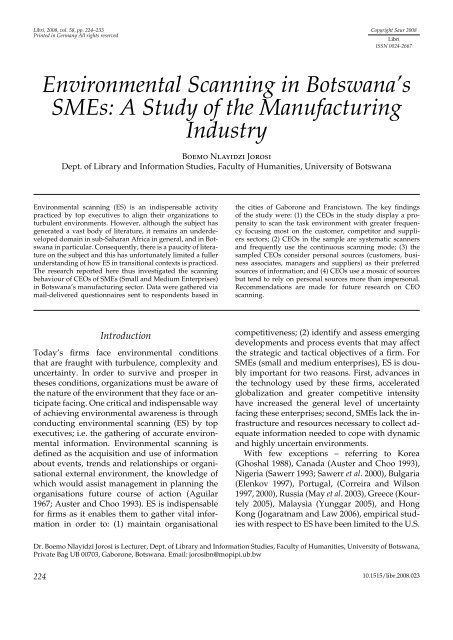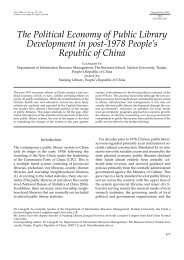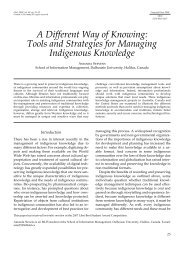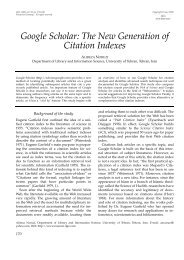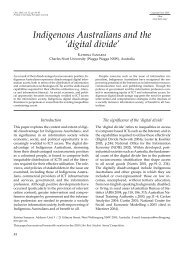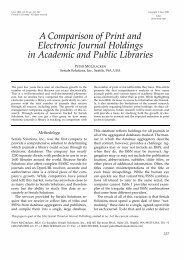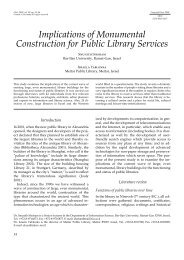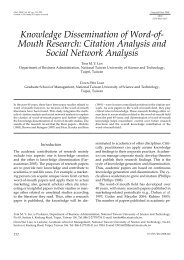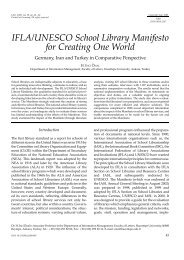Environmental Scanning in Botswana's SMEs: A Study of the ... - Libri
Environmental Scanning in Botswana's SMEs: A Study of the ... - Libri
Environmental Scanning in Botswana's SMEs: A Study of the ... - Libri
Create successful ePaper yourself
Turn your PDF publications into a flip-book with our unique Google optimized e-Paper software.
<strong>Libri</strong>, 2008, vol. 58, pp. 224–233<br />
Pr<strong>in</strong>ted <strong>in</strong> Germany All rights reserved<br />
Copyright Saur 2008<br />
<strong>Libri</strong><br />
ISSN 0024-2667<br />
<strong>Environmental</strong> <strong>Scann<strong>in</strong>g</strong> <strong>in</strong> Botswana’s<br />
<strong>SMEs</strong>: A <strong>Study</strong> <strong>of</strong> <strong>the</strong> Manufactur<strong>in</strong>g<br />
Industry<br />
Boemo Nlayidzi Jorosi<br />
Dept. <strong>of</strong> Library and Information Studies, Faculty <strong>of</strong> Humanities, University <strong>of</strong> Botswana<br />
<strong>Environmental</strong> scann<strong>in</strong>g (ES) is an <strong>in</strong>dispensable activity<br />
prac ticed by top executives to align <strong>the</strong>ir organizations to<br />
tur bulent environments. However, although <strong>the</strong> subject has<br />
gen erated a vast body <strong>of</strong> literature, it rema<strong>in</strong>s an un der devel<br />
oped doma<strong>in</strong> <strong>in</strong> sub-Saharan Africa <strong>in</strong> general, and <strong>in</strong> Botswana<br />
<strong>in</strong> particular. Consequently, <strong>the</strong>re is a paucity <strong>of</strong> lit er a-<br />
ture on <strong>the</strong> subject and this has unfortunately limited a ful ler<br />
understand<strong>in</strong>g <strong>of</strong> how ES <strong>in</strong> transitional contexts is prac ticed.<br />
The research reported here thus <strong>in</strong>vestigated <strong>the</strong> scan n<strong>in</strong>g<br />
behaviour <strong>of</strong> CEOs <strong>of</strong> <strong>SMEs</strong> (Small and Medium Enterprises)<br />
<strong>in</strong> Botswana’s manu fac tur <strong>in</strong>g sector. Data were ga<strong>the</strong>red via<br />
mail-delivered ques tion naires sent to re spon dents based <strong>in</strong><br />
<strong>the</strong> cities <strong>of</strong> Gaborone and Francistown. The key f<strong>in</strong>d<strong>in</strong>gs<br />
<strong>of</strong> <strong>the</strong> study were: (1) <strong>the</strong> CEOs <strong>in</strong> <strong>the</strong> study dis play a propensity<br />
to scan <strong>the</strong> task en vi ron ment with greater frequency<br />
focus<strong>in</strong>g most on <strong>the</strong> cus to mer, com pet i tor and suppliers<br />
sectors; (2) CEOs <strong>in</strong> <strong>the</strong> sam ple are sys te matic scanners<br />
and frequently use <strong>the</strong> con t<strong>in</strong> u ous scann<strong>in</strong>g mode; (3) <strong>the</strong><br />
sampled CEOs consider personal sour ces (cus to mers, bus<strong>in</strong>ess<br />
associates, managers and sup pliers) as <strong>the</strong>ir preferred<br />
sources <strong>of</strong> <strong>in</strong> for ma tion; and (4) CEOs use a mosaic <strong>of</strong> sources<br />
but tend to rely on personal sources more than im personal.<br />
Recommendations are made for fu ture research on CEO<br />
scann<strong>in</strong>g.<br />
Introduction<br />
Today’s firms face environmental conditions<br />
that are fraught with turbulence, complexity and<br />
uncerta<strong>in</strong>ty. In order to survive and prosper <strong>in</strong><br />
<strong>the</strong>ses conditions, organizations must be aware <strong>of</strong><br />
<strong>the</strong> nature <strong>of</strong> <strong>the</strong> environment that <strong>the</strong>y face or anticipate<br />
fac<strong>in</strong>g. One critical and <strong>in</strong>dispensable way<br />
<strong>of</strong> achiev<strong>in</strong>g environmental awareness is through<br />
conduct<strong>in</strong>g environmental scann<strong>in</strong>g (ES) by top<br />
executives; i.e. <strong>the</strong> ga<strong>the</strong>r<strong>in</strong>g <strong>of</strong> accurate environmental<br />
<strong>in</strong>formation. <strong>Environmental</strong> scann<strong>in</strong>g is<br />
def<strong>in</strong>ed as <strong>the</strong> acquisition and use <strong>of</strong> <strong>in</strong>formation<br />
about events, trends and relationships or organisational<br />
external environment, <strong>the</strong> knowledge <strong>of</strong><br />
which would assist management <strong>in</strong> plann<strong>in</strong>g <strong>the</strong><br />
organisations future course <strong>of</strong> action (Aguilar<br />
1967; Auster and Choo 1993). ES is <strong>in</strong>dispensable<br />
for firms as it enables <strong>the</strong>m to ga<strong>the</strong>r vital <strong>in</strong>formation<br />
<strong>in</strong> order to: (1) ma<strong>in</strong>ta<strong>in</strong> organisational<br />
competitiveness; (2) identify and assess emerg<strong>in</strong>g<br />
developments and process events that may affect<br />
<strong>the</strong> strategic and tactical objectives <strong>of</strong> a firm. For<br />
<strong>SMEs</strong> (small and medium enterprises), ES is doubly<br />
important for two reasons. First, advances <strong>in</strong><br />
<strong>the</strong> technology used by <strong>the</strong>se firms, accelerated<br />
globalization and greater competitive <strong>in</strong>tensity<br />
have <strong>in</strong>creased <strong>the</strong> general level <strong>of</strong> uncerta<strong>in</strong>ty<br />
fac<strong>in</strong>g <strong>the</strong>se enterprises; second, <strong>SMEs</strong> lack <strong>the</strong> <strong>in</strong>frastructure<br />
and resources necessary to collect adequate<br />
<strong>in</strong>formation needed to cope with dynamic<br />
and highly uncerta<strong>in</strong> environments.<br />
With few exceptions – referr<strong>in</strong>g to Korea<br />
(Ghoshal 1988), Canada (Auster and Choo 1993),<br />
Nigeria (Sawerr 1993; Sawerr et al. 2000), Bulgaria<br />
(Elenkov 1997), Portugal, (Correira and Wilson<br />
1997, 2000), Russia (May et al. 2003), Greece (Kourtely<br />
2005), Malaysia (Yunggar 2005), and Hong<br />
Kong (Jogaratnam and Law 2006), empirical studies<br />
with respect to ES have been limited to <strong>the</strong> U.S.<br />
Dr. Boemo Nlayidzi Jorosi is Lecturer, Dept. <strong>of</strong> Library and Information Studies, Faculty <strong>of</strong> Humanities, University <strong>of</strong> Botswana,<br />
Private Bag UB 00703, Gaborone, Botswana. Email: jorosibn@mopipi.ub.bw<br />
224<br />
10.1515/libr.2008.023
<strong>Environmental</strong> <strong>Scann<strong>in</strong>g</strong> <strong>in</strong> Botswana’s <strong>SMEs</strong><br />
However, research evidence suggests that Western<br />
<strong>the</strong>ories focus<strong>in</strong>g on organisations and <strong>the</strong>ir<br />
environments are likely to suffer from a weak fit<br />
<strong>in</strong> terms <strong>of</strong> <strong>the</strong>ir generalisability to a non-western<br />
context. Unsurpris<strong>in</strong>gly, <strong>the</strong>re are press<strong>in</strong>g calls <strong>in</strong><br />
<strong>the</strong> literature for research to exam<strong>in</strong>e ES <strong>in</strong> different<br />
national sett<strong>in</strong>gs (Ebrahimi 2000). Moreover,<br />
much <strong>of</strong> <strong>the</strong> empirical literature on ES has tended<br />
to focus on large firms at <strong>the</strong> expense <strong>of</strong> small<br />
firms which happen to be majority <strong>of</strong> firms <strong>in</strong><br />
most economies. Tak<strong>in</strong>g <strong>the</strong>se cues, this study<br />
aims to contribute to <strong>the</strong> empirical literature on<br />
ES by prob<strong>in</strong>g <strong>the</strong> scann<strong>in</strong>g behaviours <strong>of</strong> CEOs<br />
<strong>in</strong> Botswana’s manufactur<strong>in</strong>g <strong>in</strong>dustry. Botswana<br />
provides a suitable sett<strong>in</strong>g for this stream <strong>of</strong> research,<br />
as <strong>the</strong> manufactur<strong>in</strong>g sector is a significant<br />
component <strong>of</strong> <strong>the</strong> country’s diversification strategy<br />
and has thus attracted a modest population <strong>of</strong><br />
national and <strong>in</strong>ternational decision makers operat<strong>in</strong>g<br />
<strong>in</strong> one environmental sett<strong>in</strong>g.<br />
Prior studies<br />
Follow<strong>in</strong>g <strong>the</strong> pioneer<strong>in</strong>g work <strong>of</strong> Aguilar (1967),<br />
and similar classics such as Coll<strong>in</strong>gs (1968), Kefalas<br />
and Shoderbek (1973), Keegan (1974), El<br />
Sawy (1985), Ghoshal (1986), Daft et al. (1988) and<br />
Auster and Choo (1993), to name but a few, numerous<br />
enquiries have been undertaken to probe how<br />
executives scan <strong>the</strong> environment <strong>in</strong> order to align<br />
<strong>the</strong>ir organisations to <strong>the</strong> turbulent and equivocal<br />
environmental conditions. Consequently, ES as a<br />
doma<strong>in</strong> boasts an admirable body <strong>of</strong> empirical literature.<br />
Studies <strong>of</strong> environmental scann<strong>in</strong>g have<br />
dealt with <strong>the</strong> identification <strong>of</strong> environmental sectors<br />
scanned, <strong>the</strong> scann<strong>in</strong>g modes/strategies used<br />
and <strong>the</strong> identification <strong>of</strong> <strong>in</strong>formation sources utilised.<br />
Milliken (1987) suggests that it is widely accepted<br />
that environmental uncerta<strong>in</strong>ty arises from<br />
<strong>the</strong> organization’s <strong>in</strong>ability to predict its environment,<br />
or <strong>in</strong> o<strong>the</strong>r words, to predict <strong>the</strong> factors that<br />
characterise its environment. Accord<strong>in</strong>g to Dill<br />
(1958), Duncan (1972), Daft et al. (1988) and o<strong>the</strong>rs,<br />
<strong>the</strong>se factors are usually and mean<strong>in</strong>gfully classified<br />
<strong>in</strong>to two groups – “general” and “task” bus<strong>in</strong>ess<br />
external environment sectors. The general<br />
environment is a relatively remote environment<br />
and <strong>the</strong> elements that compose it have an <strong>in</strong>direct<br />
<strong>in</strong>fluence on <strong>the</strong> organization. This environment is<br />
typically composed <strong>of</strong> economic conditions, technological<br />
developments, political and regulatory<br />
environments, and socio-cultural and demographic<br />
trends. On <strong>the</strong> o<strong>the</strong>r hand, <strong>the</strong> task environment<br />
is <strong>the</strong> closest environment to <strong>the</strong> organization and<br />
<strong>the</strong> elements that compose it have a direct <strong>in</strong>fluence<br />
on <strong>the</strong> organization. This environment is<br />
typically composed <strong>of</strong> sectors such as customers,<br />
suppliers and competitors.<br />
Several scholars, (see for example, Duncan<br />
(1972), Daft et al. (1988), Auster and Choo (1993)),<br />
argue that <strong>the</strong> factors <strong>in</strong> <strong>the</strong> task environment<br />
usually create greater perceived uncerta<strong>in</strong>ty to<br />
organizations than sectors <strong>in</strong> <strong>the</strong> general environment.<br />
This is because it is believed that <strong>the</strong> task environment,<br />
which is connected with <strong>the</strong> short-run,<br />
is more volatile than <strong>the</strong> general environment,<br />
which is connected with <strong>the</strong> long-run.<br />
A closer scrut<strong>in</strong>y <strong>of</strong> <strong>the</strong> environmental sectors<br />
scanned by top executives reveals some startl<strong>in</strong>g<br />
parallels with research from <strong>the</strong> subfield <strong>of</strong> <strong>in</strong>formation<br />
behaviour. Research from this stream<br />
<strong>of</strong> knowledge suggests <strong>the</strong> types <strong>of</strong> <strong>in</strong>formation<br />
sought by managers are largely dependent upon<br />
<strong>the</strong> context <strong>in</strong> which <strong>the</strong> executive works. Three<br />
dist<strong>in</strong>ct managerial roles are identified: operational<br />
tasks, control/tactical tasks, and strategic tasks<br />
(see Butcher (1998) for a detailed discussion). Because<br />
<strong>of</strong> <strong>the</strong> dictates and peculiarity <strong>of</strong> each role,<br />
<strong>the</strong> precise resultant <strong>in</strong>formation needs and <strong>the</strong><br />
sources used are bound to mirror <strong>the</strong> different<br />
roles <strong>the</strong> CEO is predom<strong>in</strong>antly execut<strong>in</strong>g.<br />
With reference to scann<strong>in</strong>g modes/strategies, it<br />
has been observed from extant research that perceived<br />
strategic uncerta<strong>in</strong>ty that arises from environmental<br />
sectors impels firms to seek <strong>in</strong>formation<br />
to try and diagnose <strong>the</strong> conditions prevail<strong>in</strong>g<br />
<strong>in</strong> <strong>the</strong> organization (May et al. 2000). To this end,<br />
several typologies <strong>of</strong> scann<strong>in</strong>g have been made<br />
<strong>in</strong> <strong>the</strong> empirical studies <strong>of</strong> ES. For example, <strong>the</strong><br />
typology proposed by Aguilar (1967) consists <strong>of</strong><br />
4 categories: (1) undirected view<strong>in</strong>g; general scann<strong>in</strong>g<br />
<strong>in</strong> which <strong>the</strong> viewer does not have a particular<br />
purpose <strong>in</strong> m<strong>in</strong>d; (2) conditioned view<strong>in</strong>g; directed<br />
exposure, but not active search <strong>of</strong> an identified<br />
area or type <strong>of</strong> <strong>in</strong>formation; (3) <strong>in</strong>formation<br />
search; relatively unstructured effort to obta<strong>in</strong> a<br />
particular bit <strong>of</strong> <strong>in</strong>formation for a specific purpose;<br />
(4) formal search; deliberate planned search to obta<strong>in</strong><br />
specific <strong>in</strong>formation for a particular purpose.<br />
Likewise El Sawy (1985) identifies four scann<strong>in</strong>g<br />
modes. First, <strong>the</strong>re is <strong>the</strong> null mode <strong>of</strong> passive<br />
225
Boemo Nlayidzi Jorosi<br />
scann<strong>in</strong>g (no scann<strong>in</strong>g <strong>in</strong> which <strong>the</strong> CEO is be<strong>in</strong>g<br />
pushed unsolicited <strong>in</strong>formation, “unsolicited<br />
reception”). Next, is <strong>the</strong> “problemistic search”, a<br />
reactive mode <strong>in</strong> which <strong>the</strong> CEO is actively search<strong>in</strong>g<br />
for solutions to specific problems. Third, <strong>the</strong>re<br />
are two proactive scann<strong>in</strong>g modes which are<br />
generically called “surveillance”. Surveillance<br />
is broken down <strong>in</strong>to two modes: “co<strong>in</strong>cidental<br />
surveillance” and “rout<strong>in</strong>e monitor<strong>in</strong>g” while<br />
“Co<strong>in</strong>cidental surveillance” <strong>in</strong>volves <strong>the</strong> serendipitous<br />
surveillance <strong>of</strong> “non-habitual” <strong>in</strong>formation<br />
sources. “Rout<strong>in</strong>e monitor<strong>in</strong>g” <strong>in</strong>volves <strong>the</strong><br />
systematic surveillance <strong>of</strong> “habitual <strong>in</strong>formation<br />
sources”. A “habitual <strong>in</strong>formation source” is one<br />
that <strong>the</strong> manager accesses on a regular basis<br />
while a “non-habitual <strong>in</strong>formation source” is one<br />
<strong>in</strong> which <strong>the</strong> manager may never have accessed<br />
before or may never access aga<strong>in</strong> (El Sawy 1985,<br />
78). Fur<strong>the</strong>r, Smeltzer et al. (1988) provide a simple<br />
and relevant scann<strong>in</strong>g strategy compris<strong>in</strong>g three<br />
modes: irregular, periodic and cont<strong>in</strong>uous. Each<br />
<strong>of</strong> <strong>the</strong> modes refers to <strong>the</strong> frequency <strong>of</strong> scann<strong>in</strong>g<br />
performed by CEOs. The irregular mode is characterised<br />
by little scann<strong>in</strong>g activity. With respect to<br />
periodic scann<strong>in</strong>g, <strong>the</strong> CEO has a pattern <strong>of</strong> scann<strong>in</strong>g<br />
at <strong>in</strong>tervals while cont<strong>in</strong>uous scann<strong>in</strong>g is an<br />
<strong>in</strong>tegral part <strong>of</strong> rout<strong>in</strong>e work.<br />
Notwithstand<strong>in</strong>g <strong>the</strong> variety <strong>in</strong> scann<strong>in</strong>g modes,<br />
several common <strong>the</strong>mes seem to emerge. For example,<br />
exist<strong>in</strong>g empirical evidence suggests that<br />
<strong>the</strong> frequency and <strong>in</strong>terest <strong>in</strong> scann<strong>in</strong>g can be high<br />
or low (Hambrick 1982; Sawyerr 1993) and passive<br />
or active. Firms can use advanced or elementary<br />
scann<strong>in</strong>g systems (Subramanian et al. 1994)<br />
and formal or <strong>in</strong>formal structures. F<strong>in</strong>ally, most<br />
studies are <strong>in</strong> concordance that perceived strategic<br />
uncerta<strong>in</strong>ty that arises from environmental sectors<br />
impels firms to scan for <strong>in</strong>formation with a view to<br />
diagnose <strong>the</strong> prevail<strong>in</strong>g environmental conditions<br />
(May et al. 2000).<br />
Mov<strong>in</strong>g on to characteristics <strong>of</strong> sources <strong>of</strong> <strong>in</strong>formation,<br />
several scholars have classified sources<br />
broadly as “external” and “<strong>in</strong>ternal”. External<br />
sources <strong>of</strong> <strong>in</strong>formation orig<strong>in</strong>ate outside <strong>the</strong> organization<br />
whereas <strong>in</strong>ternal sources <strong>of</strong> <strong>in</strong>formation<br />
orig<strong>in</strong>ate with<strong>in</strong> <strong>the</strong> organization (Aguilar<br />
1967; El Sawy 1985; Auster and Choo 1993). Fur<strong>the</strong>rmore,<br />
<strong>the</strong>se two categories are sub-classified<br />
<strong>in</strong>to “personal” and “impersonal” sources. On <strong>the</strong><br />
one hand, personal sources orig<strong>in</strong>ate from personal<br />
contacts with people <strong>in</strong>side and outside<br />
<strong>the</strong> organization. On <strong>the</strong> o<strong>the</strong>r hand, impersonal<br />
sources orig<strong>in</strong>ate from sources such as documents,<br />
databases, etc. (Aguilar 1967; El Sawy 1985; Auster<br />
and Choo 1993; Sawerr et al. 2000), evidence referr<strong>in</strong>g<br />
to <strong>the</strong> importance <strong>of</strong> personal versus impersonal<br />
sources and <strong>in</strong>ternal versus external sources<br />
is <strong>in</strong>conclusive (Sawerr et al. 2000), it is widely<br />
argued that personal sources are more important<br />
than impersonal resources (Aguilar 1967; Johnson<br />
and Kuehn 1987; Daft et al. 1988; Elenkov 1997)<br />
and that external resources are more important<br />
than <strong>in</strong>ternal resources (Aguilar 1967; Keegan<br />
1974; Elenkov 1997). In <strong>the</strong> particular context <strong>of</strong><br />
<strong>SMEs</strong>, many studies have observed that managers<br />
<strong>of</strong> <strong>SMEs</strong> more frequently use sources that are<br />
personal (Specht 1987), external (Johnson and<br />
Kuehn 1987), and <strong>in</strong>formal (Smeltzer, Fann and<br />
Nikolaisen 1988).<br />
Given that, to date, no study <strong>of</strong> ES by CEOs <strong>in</strong><br />
Botswana has been reported <strong>in</strong> <strong>the</strong> literature, it<br />
was <strong>the</strong>refore considered important to undertake<br />
this research <strong>in</strong> order to understand <strong>the</strong> scann<strong>in</strong>g<br />
behaviour CEOs <strong>in</strong> Botswana.<br />
Objectives <strong>of</strong> <strong>the</strong> study<br />
The purpose <strong>of</strong> <strong>the</strong> study was to <strong>in</strong>vestigate <strong>the</strong><br />
scann<strong>in</strong>g practices <strong>of</strong> <strong>SMEs</strong> executives <strong>in</strong> <strong>the</strong> manufactur<strong>in</strong>g<br />
sector. Specifically, <strong>the</strong> <strong>in</strong>quiry sought<br />
to provide answers to <strong>the</strong> follow<strong>in</strong>g research questions:<br />
1. Which environmental sectors receive greater scann<strong>in</strong>g<br />
attention by CEOs?<br />
2. What are <strong>the</strong> prevalent scann<strong>in</strong>g strategies/modes<br />
used by CEOs?<br />
3. Which sources are rated important by CEOs?<br />
4. Which <strong>in</strong>formation sources are used by CEOs?<br />
Research methodology<br />
Research sett<strong>in</strong>g<br />
Botswana is a land-locked nation centred <strong>in</strong> Sub-<br />
Saharan Africa. Over <strong>the</strong> past 35 years, Botswana<br />
has been among <strong>the</strong> best perform<strong>in</strong>g economies <strong>in</strong><br />
Africa. From one <strong>of</strong> <strong>the</strong> world’s poorest countries<br />
it has evolved <strong>in</strong>to a middle-<strong>in</strong>come country.<br />
The discovery and prudent management <strong>of</strong> its<br />
vast diamond resources toge<strong>the</strong>r with sound<br />
economic policies have elevated <strong>the</strong> country to <strong>the</strong><br />
226
<strong>Environmental</strong> <strong>Scann<strong>in</strong>g</strong> <strong>in</strong> Botswana’s <strong>SMEs</strong><br />
level where it is no longer considered poor. The<br />
population <strong>of</strong> Botswana is 1.68 million with a per<br />
capita <strong>in</strong>come <strong>of</strong> US$3,000. Approximately 3.4%<br />
<strong>of</strong> Batswana <strong>in</strong> formal employment are employed<br />
<strong>in</strong> <strong>the</strong> diamond <strong>in</strong>dustry while unemployment<br />
rema<strong>in</strong>s high at 20%, with 37% <strong>of</strong> <strong>the</strong> population<br />
liv<strong>in</strong>g below <strong>the</strong> poverty l<strong>in</strong>e. Botswana’s record<br />
<strong>in</strong> human development is equally impressive, with<br />
one important exception – HIV/AIDS <strong>in</strong>fection,<br />
which has dramatically reduced life expectancy<br />
from 67 to 47 years (UNAIDS 2006). Major emphasis<br />
has been placed on provid<strong>in</strong>g basic education<br />
and primary health care throughout <strong>the</strong><br />
country.<br />
The heavy dependence <strong>of</strong> <strong>the</strong> economy on<br />
diamonds (83% <strong>of</strong> merchandise exports) leaves it<br />
vulnerable to trade shocks, and this has prompted<br />
<strong>the</strong> Government <strong>of</strong> Botswana to promote economic<br />
diversification. To this end, manufactur<strong>in</strong>g<br />
and tourism have been identified as <strong>the</strong> tw<strong>in</strong> pillars<br />
<strong>of</strong> <strong>the</strong> economic diversification strategy. To<br />
achieve economic diversification, government has<br />
undertaken a wide range <strong>of</strong> proactive and vigorous<br />
measures to create an overall enabl<strong>in</strong>g<br />
environment. Salient among <strong>the</strong>se policies have<br />
been <strong>in</strong>fra-structural development, taxation, fiscal<br />
policy, exchange rate controls, low-cost f<strong>in</strong>ance<br />
schemes (e.g. Citizen Entrepreneurial Agency,<br />
CEDA) and <strong>the</strong> <strong>in</strong>troduction <strong>of</strong> policies promot<strong>in</strong>g<br />
free market enterprise. To date, Botswana<br />
prides itself as a lead<strong>in</strong>g and sh<strong>in</strong><strong>in</strong>g democracy<br />
with an <strong>in</strong>vestor-friendly environment and has attracted<br />
a significant number <strong>of</strong> foreign <strong>in</strong>vestors.<br />
Based on its impressive performance, Botswana is<br />
rated highly by <strong>in</strong>ternational organizations on a<br />
number <strong>of</strong> <strong>in</strong>dicators. Transparency International<br />
has rated Botswana for three consecutive years as<br />
<strong>the</strong> least corrupt country <strong>in</strong> Africa, and among <strong>the</strong><br />
least corrupt <strong>in</strong> <strong>the</strong> world. Similarly, Botswana<br />
has received 68.6 per cent rat<strong>in</strong>g <strong>in</strong> <strong>the</strong> Heritage<br />
Foundation 2008 Index <strong>of</strong> Economic Freedom and<br />
ranks 36 <strong>in</strong> global rank<strong>in</strong>g (BEDIA 2008).<br />
The manufactur<strong>in</strong>g sector is vital to <strong>the</strong> economy<br />
<strong>of</strong> Botswana. S<strong>in</strong>ce <strong>the</strong> late 1980s, successive<br />
national development plans have identified this<br />
sector as <strong>the</strong> central tool to achieve <strong>the</strong> country’s<br />
diversification strategy, i.e. mov<strong>in</strong>g <strong>the</strong> economy<br />
away from its s<strong>in</strong>gle dependency on <strong>the</strong> m<strong>in</strong>eral<br />
sector. Presently, <strong>the</strong> sector is <strong>the</strong> second contributor<br />
to <strong>the</strong> Gross Domestic Product after <strong>the</strong> m<strong>in</strong><strong>in</strong>g<br />
sector and absorbs a considerable number<br />
<strong>of</strong> relatively poorly educated people from <strong>the</strong><br />
country’s high school system (approximately 10%<br />
<strong>of</strong> <strong>the</strong> workforce). At <strong>the</strong> same time, <strong>the</strong> <strong>in</strong>dustry<br />
thrives <strong>in</strong> a turbulent market characterized by an<br />
<strong>in</strong>cessant current flood <strong>of</strong> imported cheap goods<br />
particularly textile materials from Sou<strong>the</strong>ast Asia,<br />
especially Ch<strong>in</strong>a.<br />
Data collection<br />
A survey research method was adopted to <strong>in</strong>vestigate<br />
<strong>the</strong> scann<strong>in</strong>g behaviour <strong>of</strong> CEOs <strong>of</strong> 113 <strong>SMEs</strong><br />
randomly selected from <strong>the</strong> cities <strong>of</strong> Francistown<br />
and Gaborone between late 2005 and early 2006.<br />
The sample frame consisted <strong>of</strong> all <strong>the</strong> CEOs listed<br />
<strong>in</strong> <strong>the</strong> authoritative and comprehensive Manufacturers<br />
Directory 2005. Small firms were def<strong>in</strong>ed as<br />
companies hav<strong>in</strong>g 6 to 25 paid employees while<br />
medium firms were def<strong>in</strong>ed as hav<strong>in</strong>g paid employees<br />
rang<strong>in</strong>g form 26 to 99 (SMME Task Force<br />
1997). Follow<strong>in</strong>g <strong>the</strong> above def<strong>in</strong>itions, micro-entrepreneurs<br />
and large firms were excluded from<br />
<strong>the</strong> sample. Contact details and names <strong>of</strong> CEOs<br />
were obta<strong>in</strong>ed for <strong>the</strong> sample. The cover letter<br />
expla<strong>in</strong><strong>in</strong>g <strong>the</strong> purpose <strong>of</strong> <strong>the</strong> research along with<br />
<strong>the</strong> questionnaire was mailed to <strong>the</strong> sample <strong>of</strong> 300<br />
thus identified. To boost <strong>the</strong> response rate, followup<br />
mails and phone calls were made to those who<br />
had not responded with<strong>in</strong> 3 weeks <strong>of</strong> <strong>the</strong> <strong>in</strong>itial<br />
mail<strong>in</strong>g (Dillman 2000). After rem<strong>in</strong>ders and fur<strong>the</strong>r<br />
telephone calls, a total <strong>of</strong> 113 questionnaires<br />
were returned. Of <strong>the</strong> 113, three were discarded<br />
because <strong>of</strong> miss<strong>in</strong>g data, leav<strong>in</strong>g 110 usable questionnaires<br />
for a response rate <strong>of</strong> 37%.<br />
Follow<strong>in</strong>g several notable prior studies (e.g. El<br />
Sawy 1985; Ghoshal 1988), data were analyzed us<strong>in</strong>g<br />
simple descriptive statistics, frequencies and<br />
percentages.<br />
Characteristics <strong>of</strong> respond<strong>in</strong>g firms:<br />
The manufactur<strong>in</strong>g <strong>in</strong>dustry comprises quite diverse<br />
sectors rang<strong>in</strong>g from Standard Industrial<br />
Code (SIC) 1510 (meat and meat products) through<br />
SIC 3700 (regard<strong>in</strong>g process<strong>in</strong>g <strong>of</strong> metal waste).<br />
Of <strong>the</strong> 110 <strong>SMEs</strong> respond<strong>in</strong>g to <strong>the</strong> questionnaire,<br />
39 (35%) were textile firms, 40 (36%) were tann<strong>in</strong>g<br />
and lea<strong>the</strong>r bus<strong>in</strong>esses and 31 (28%) were gra<strong>in</strong>mill<strong>in</strong>g<br />
operations. These <strong>SMEs</strong> consisted <strong>of</strong> 67<br />
(61%) small firms and 43 (39%) medium-sized<br />
companies. Most <strong>of</strong> <strong>the</strong> sample firms (65%) had<br />
227
Boemo Nlayidzi Jorosi<br />
Table 1: Respondent Pr<strong>of</strong>ile<br />
Title Frequency Percentage<br />
CEO<br />
Manag<strong>in</strong>g Director<br />
Manager<br />
33<br />
49<br />
28<br />
30<br />
45<br />
25<br />
Years <strong>in</strong> present position<br />
11 years<br />
Years <strong>in</strong> <strong>in</strong>dustry<br />
< 4 years<br />
5–9 years<br />
10–15 years<br />
>16 years<br />
Educational background<br />
Primary<br />
Secondary<br />
Tertiary<br />
Undergraduate<br />
Post graduate<br />
Age<br />
30– 35 years<br />
36–40 years<br />
41–50 years<br />
51– 67 Years<br />
Gender<br />
Male<br />
Female<br />
been operat<strong>in</strong>g <strong>in</strong> Botswana for a period between<br />
5–15 years and only (18%) had been <strong>in</strong> <strong>the</strong> <strong>in</strong>dustry<br />
for over 15 years. The majority <strong>of</strong> <strong>the</strong> firms, 60<br />
(55%), were owned by Botswana citizens, while<br />
27 (25%) were owned by foreign citizens and 23<br />
(21%) were jo<strong>in</strong>t ownership.<br />
Pr<strong>of</strong>ile <strong>of</strong> survey respondents<br />
34<br />
50<br />
26<br />
19<br />
26<br />
45<br />
20<br />
10<br />
53<br />
22<br />
17<br />
8<br />
20<br />
25<br />
46<br />
19<br />
91<br />
19<br />
Table 2: <strong>Environmental</strong> sectors scanned by CEOs<br />
31<br />
45<br />
24<br />
17<br />
24<br />
41<br />
18<br />
9<br />
48<br />
20<br />
15<br />
7<br />
18<br />
23<br />
42<br />
17<br />
83<br />
17<br />
Task Environment Frequency Percentage<br />
Customers 104 95<br />
Competitors 101 92<br />
Suppliers 98 89<br />
General Environment<br />
Economic 95 86<br />
Regulatory 79 72<br />
Technological 70 64<br />
Social 65 59<br />
Demographic 59 54<br />
Political 30 27<br />
The ages <strong>of</strong> <strong>the</strong> respondents ranged from 30 to<br />
67 and <strong>the</strong> vast majority <strong>of</strong> <strong>the</strong> CEOs (65%) were<br />
between 36 and 50 years old and only (17%) <strong>of</strong> <strong>the</strong><br />
respondents were between 51–67. With respect<br />
Table 3: Usage <strong>of</strong> scann<strong>in</strong>g modes<br />
<strong>Scann<strong>in</strong>g</strong> Mode Frequency Percentage<br />
Cont<strong>in</strong>uous 73 66<br />
Periodic 23 21<br />
Irregular 14 13<br />
Total 110 100<br />
to gender, <strong>the</strong> sample was preponderantly male<br />
(83%). Fur<strong>the</strong>rmore, <strong>the</strong> qualifications possessed<br />
by <strong>the</strong> CEOs varied considerably from primary to<br />
postgraduate education. However, <strong>the</strong> majority <strong>of</strong><br />
<strong>the</strong> CEOs (68%) possessed secondary and tertiary<br />
qualifications. The multivariable Table 1 presents<br />
a pr<strong>of</strong>ile <strong>of</strong> <strong>the</strong> respondents.<br />
In an attempt to provide answers to <strong>the</strong> questions<br />
about <strong>the</strong> external sectors which received<br />
<strong>the</strong> greatest scann<strong>in</strong>g attention, respondents were<br />
asked to rate on a 4-po<strong>in</strong>t scale (1 = not frequent,<br />
4 = most frequently) <strong>the</strong> sector on which <strong>the</strong>y<br />
scanned for <strong>in</strong>formation. Table 2 presents <strong>the</strong> survey<br />
responses to <strong>the</strong> question. Clearly, three <strong>of</strong> <strong>the</strong><br />
most scanned sectors were components <strong>of</strong> <strong>the</strong> task<br />
environment: customers (95%), competitors (92%)<br />
and suppliers (89%). In <strong>the</strong> general environment,<br />
<strong>the</strong> economic sector (86%) received <strong>the</strong> greatest<br />
scann<strong>in</strong>g attention, while <strong>the</strong> political sector received<br />
<strong>the</strong> least scann<strong>in</strong>g attention with only 27%.<br />
Usage <strong>of</strong> different scann<strong>in</strong>g modes by CEOs<br />
Follow<strong>in</strong>g Smeltzer, Fann and Nikolaisen (1988),<br />
CEOs were asked to <strong>in</strong>dicate <strong>the</strong>ir modes <strong>of</strong><br />
scann<strong>in</strong>g by select<strong>in</strong>g from <strong>the</strong> follow<strong>in</strong>g search<br />
modes: Irregular (less than 2 hours per month);<br />
Periodic (1–2 hours per fortnight); and Cont<strong>in</strong>uous<br />
(30–60 m<strong>in</strong>utes per week). Table 3 depicts <strong>the</strong> results<br />
<strong>of</strong> responses.<br />
This data suggests that although CEOs <strong>in</strong> <strong>the</strong><br />
sample make use <strong>of</strong> <strong>the</strong> three scann<strong>in</strong>g modes,<br />
<strong>the</strong>y frequently use <strong>the</strong> cont<strong>in</strong>uous mode, and <strong>the</strong><br />
irregular mode enjoys <strong>the</strong> least usage.<br />
Sources rated important by CEOs<br />
To ga<strong>the</strong>r data about <strong>the</strong> perceived importance<br />
associated with <strong>the</strong> various sources <strong>of</strong> <strong>in</strong>formation,<br />
a Likert-type scale <strong>of</strong> 1–4 (not important to<br />
very important) was used. Table 4 below presents<br />
<strong>the</strong> results <strong>of</strong> <strong>the</strong> <strong>in</strong>formation sources preferred by<br />
CEOs. The sampled CEOs rated customers (96%)<br />
as <strong>the</strong>ir most preferred source.<br />
228
<strong>Environmental</strong> <strong>Scann<strong>in</strong>g</strong> <strong>in</strong> Botswana’s <strong>SMEs</strong><br />
Table 4: Sources rated important by CEOs<br />
<strong>Environmental</strong> source F %<br />
External sources<br />
Customers 106 96<br />
Bus<strong>in</strong>ess associates 98 89<br />
Suppliers 95 86<br />
Newspaper/radical 89 81<br />
Broadcast media 87 79<br />
www/Internet 46 42<br />
Trade shows conventions 45 41<br />
External reports studies 40 36<br />
Trade publications 39 35<br />
Consultants 13 12<br />
Internal Sources<br />
Managers/supervisors 95 86<br />
Internal reports 84 76<br />
Peers/colleagues 80 73<br />
Subord<strong>in</strong>ates 43 39<br />
Table 5: Sources used scann<strong>in</strong>g by CEOs<br />
<strong>Environmental</strong> Source Frequency %<br />
External sources<br />
Customers 109 99<br />
Bus<strong>in</strong>ess associates 100 91<br />
Suppliers 97 88<br />
Newspapers/periodicals 96 87<br />
Broadcast media (TV, radio) 90 82<br />
World Wide Web 47 43<br />
Trade shows 50 45<br />
Conventions 46 42<br />
External reports/studies 45 41<br />
Trade publications 40 36<br />
Consultants 9 8<br />
Internal<br />
Managers/supervisors 99 90<br />
Internal reports/studies 70 64<br />
Peers/colleagues 65 59<br />
Subord<strong>in</strong>ates 43 39<br />
The next most highly rated sources were bus<strong>in</strong>ess<br />
associates (89%), managers and supervisors<br />
(86%), suppliers (86%), and newspapers/<br />
periodicals (81%). Consultants were considered<br />
to be <strong>the</strong> least <strong>in</strong> importance with a 12% rat<strong>in</strong>g. A<br />
strik<strong>in</strong>g feature <strong>of</strong> <strong>the</strong> data is <strong>the</strong> low rat<strong>in</strong>g (42%)<br />
accorded to <strong>the</strong> WWW despite <strong>the</strong> fact that we are<br />
now <strong>in</strong> <strong>the</strong> <strong>in</strong>formation age <strong>in</strong> which electronic<br />
sources are seen as key <strong>in</strong>formation sources.<br />
Sources used <strong>in</strong> scann<strong>in</strong>g<br />
The sources used <strong>in</strong> scann<strong>in</strong>g practices were assessed<br />
on an ascend<strong>in</strong>g Likert-type scale <strong>of</strong> 1–4<br />
(seldom used to very frequently). Table 5 provides a<br />
list<strong>in</strong>g <strong>of</strong> <strong>the</strong> various sources <strong>of</strong> <strong>in</strong>formation used<br />
by <strong>the</strong> executives <strong>in</strong> <strong>the</strong> study sample.<br />
Data reveals that while CEOs <strong>in</strong> <strong>the</strong> study used<br />
a variety <strong>of</strong> sources, <strong>the</strong> most frequently used<br />
sources were personal sources: customers (99%),<br />
bus<strong>in</strong>ess associates (91%), managers and supervisors<br />
(90%) and suppliers (88%). Among <strong>the</strong> impersonal<br />
sources, newspapers/periodicals (87%)<br />
and broadcast media (82%) stand out as <strong>the</strong> most<br />
frequently utilized sources <strong>of</strong> environmental <strong>in</strong>formation.<br />
Subord<strong>in</strong>ates (39%), trade publications<br />
(36%) and consultants (8%) were rated <strong>the</strong> least<br />
used. What is also surpris<strong>in</strong>g is <strong>the</strong> <strong>in</strong>frequent use<br />
<strong>of</strong> <strong>the</strong> World Wide Web with only 43% usage. Although<br />
<strong>the</strong> overall array <strong>of</strong> sources used by CEOs<br />
<strong>in</strong> <strong>the</strong> sample is skewed towards external sources,<br />
it is apparent that respondents tend to rely more<br />
on external sources. For example, two <strong>of</strong> <strong>the</strong> most<br />
frequently used sources are external sources and<br />
so are <strong>the</strong> subsequent sources after managers/<br />
supervisors.<br />
Discussion<br />
The purpose <strong>of</strong> this study was to <strong>in</strong>vestigate <strong>the</strong><br />
environmental scann<strong>in</strong>g practices <strong>of</strong> SME executives<br />
<strong>in</strong> <strong>the</strong> manufactur<strong>in</strong>g <strong>in</strong>dustry <strong>of</strong> Botswana.<br />
What picture emerges form this study? An analysis<br />
<strong>of</strong> <strong>the</strong> data collected <strong>in</strong> <strong>the</strong> research reveals that<br />
(customers, competitors, suppliers) are <strong>the</strong> most<br />
frequently scanned sectors <strong>of</strong> <strong>the</strong> environment.<br />
This f<strong>in</strong>d<strong>in</strong>g is <strong>in</strong> concordance with <strong>the</strong> f<strong>in</strong>d<strong>in</strong>gs<br />
<strong>of</strong> studies conducted <strong>in</strong> o<strong>the</strong>r places around <strong>the</strong><br />
world (see for example, Jogarathnam and Law<br />
2006; Poopola 2000; Daft et al. 1988). However, a<br />
closer exam<strong>in</strong>ation <strong>of</strong> some extant prior studies reveals<br />
a somewhat discordant picture. Whilst four<br />
studies, (Daft et al. 1988; Sawerr 1993; May et al.<br />
2000; Jogarathnam and Law 2006) all ranked customers<br />
(task environment) as <strong>the</strong> most frequently<br />
scanned sector, <strong>in</strong> contrast, two studies (Elenkov<br />
1997; Kourtely 2005) reported <strong>the</strong> political and legal<br />
and economic sectors respectively, as <strong>the</strong> most<br />
frequently scanned sectors and both are components<br />
<strong>of</strong> <strong>the</strong> general environment.<br />
229
Boemo Nlayidzi Jorosi<br />
Our f<strong>in</strong>d<strong>in</strong>gs, toge<strong>the</strong>r with those <strong>of</strong> o<strong>the</strong>r<br />
empirical studies (e.g. Jogarathnam and Law<br />
2006; May et al. 2000; Sawerr 1993; and Daft et<br />
al. 1988) lend support to <strong>the</strong> notion that whilst<br />
environmental scann<strong>in</strong>g is concerned with all <strong>the</strong><br />
relevant external factors that <strong>in</strong>fluence <strong>the</strong> health<br />
and survival <strong>of</strong> a firm, it tends to concentrate on<br />
customers, competition and suppliers. That CEOs<br />
prize <strong>in</strong>formation perta<strong>in</strong><strong>in</strong>g to <strong>the</strong> task environment<br />
(customers, competition and suppliers) is<br />
unsurpris<strong>in</strong>g. In <strong>the</strong>se times <strong>of</strong> <strong>in</strong>creas<strong>in</strong>g global<br />
competition, heightened customer awareness and<br />
evolv<strong>in</strong>g customer needs, CEOs more than ever<br />
before must ga<strong>the</strong>r <strong>in</strong>formation perta<strong>in</strong><strong>in</strong>g to <strong>the</strong><br />
task environment <strong>in</strong> order to help <strong>the</strong>ir firms to<br />
survive and prosper. After all, <strong>the</strong>se are <strong>the</strong> sectors<br />
that directly impact upon <strong>the</strong> success <strong>of</strong> <strong>the</strong><br />
firm, and failure to scan for <strong>in</strong>formation perta<strong>in</strong><strong>in</strong>g<br />
to <strong>the</strong>se sectors could mean a one-way ticket<br />
to ext<strong>in</strong>ction.<br />
CEOs <strong>in</strong> <strong>the</strong> study tend to use all three scann<strong>in</strong>g<br />
modes to ga<strong>the</strong>r <strong>in</strong>formation. However, <strong>the</strong><br />
cont<strong>in</strong>uous mode (66%) preponderates while <strong>the</strong><br />
irregular mode (13%) is <strong>the</strong> least used. This f<strong>in</strong>d<strong>in</strong>g<br />
is <strong>in</strong> agreement with similar studies conducted<br />
elsewhere (Aguilar 1967; Ghoshal 1988; Sawyerr<br />
1993; Nikolaisen 1988). Several scholars (Milliken<br />
1997; Daft et al. 1988; Auster and Choo 1993; Boyd<br />
and Fulk 1996) suggest that perceived strategic<br />
uncerta<strong>in</strong>ty will lead organizations to follow different<br />
scann<strong>in</strong>g strategies. In <strong>the</strong> context <strong>of</strong> Botswana,<br />
<strong>in</strong>creased perceived strategic uncerta<strong>in</strong>ty<br />
may be attributed to <strong>the</strong> <strong>in</strong>flux <strong>of</strong> foreign companies<br />
lured by <strong>the</strong> bus<strong>in</strong>ess-friendly environment<br />
that has been created by government <strong>in</strong> order to<br />
achieve economic diversification. Government has<br />
been mak<strong>in</strong>g vigorous efforts to woo <strong>in</strong>vestors<br />
both local and foreign through a variety <strong>of</strong> <strong>in</strong>centives<br />
and strategies (e.g. 15% corporate tax and<br />
low-cost f<strong>in</strong>ance schemes such CEDA. None<strong>the</strong>less,<br />
<strong>the</strong> scann<strong>in</strong>g patterns uncovered <strong>in</strong> <strong>the</strong> study<br />
provide a clear rebuttal to <strong>the</strong> pervasive notion <strong>in</strong><br />
<strong>the</strong> ES literature that because <strong>SMEs</strong> are resourcepoor,<br />
<strong>the</strong>ir CEOs cannot afford to scan <strong>the</strong> environment.<br />
Turn<strong>in</strong>g to <strong>the</strong> sources rated important by<br />
CEOs, <strong>the</strong> results <strong>of</strong> <strong>the</strong> study reported here suggest<br />
that CEOs considered customers (95%) as<br />
<strong>the</strong>ir most preferred source. The next most highly<br />
rated sources were: bus<strong>in</strong>ess associates (89%),<br />
managers and supervisors (86%), suppliers (86%),<br />
and newspapers/periodicals (81%). Clearly, this<br />
study suggests that CEOs <strong>in</strong> this sample place a<br />
great deal <strong>of</strong> importance on personal sources as<br />
opposed to impersonal sources. This f<strong>in</strong>d<strong>in</strong>g is<br />
consistent with relevant prior studies on source<br />
preference (Johnson and Kuehn 1987; Smeltzer et<br />
al. 1988; Vaughn 1996). However <strong>the</strong> results <strong>of</strong> this<br />
study seem to contradict Trott and Mart<strong>in</strong> (1996),<br />
Roberts et al. (1987) and Marcella et al. (1996) who<br />
found that CEOs rated technology and market <strong>in</strong>formation<br />
as <strong>the</strong> most important type <strong>of</strong> <strong>in</strong>formation<br />
to <strong>the</strong>m.<br />
F<strong>in</strong>ally, most CEOs <strong>in</strong> <strong>the</strong> study display a propensity<br />
to use a mosaic <strong>of</strong> sources both personal<br />
and impersonal, but it is personal sources that<br />
CEOs use most. Among <strong>the</strong> personal sources, customers<br />
(99%) were <strong>the</strong> most frequently used source<br />
followed by bus<strong>in</strong>ess associates (91%), managers<br />
and supervisors (90%) and suppliers (88%). This<br />
f<strong>in</strong>d<strong>in</strong>g is <strong>in</strong> concordance with previous studies<br />
on <strong>the</strong> sources utilised by managers (Aguilar<br />
1967; Keegan 1974; Preble et al. 1998) who found a<br />
greater reliance on personal or human sources. In<br />
a similar ve<strong>in</strong>, Johnson and Kuehn (1987) reported<br />
that small bus<strong>in</strong>ess CEOs used more verbal media<br />
than pr<strong>in</strong>ted sources. At <strong>the</strong> same time this result<br />
is somewhat <strong>in</strong> dissonance with f<strong>in</strong>d<strong>in</strong>gs reported<br />
<strong>in</strong> previous research (Auster and Choo 1993; Choo<br />
et al. 2000). All, however, reported preferences<br />
for external sources (e.g. radio, TV, newspapers<br />
and World Wide Web) over both <strong>in</strong>ternal people<br />
sources (e.g. managers, colleagues) and external<br />
people sources (e.g. customers, competitors).<br />
Implications for library and <strong>in</strong>formation<br />
services<br />
The study reported here has several important<br />
implications for library and <strong>in</strong>formation services.<br />
First an important f<strong>in</strong>d<strong>in</strong>g <strong>of</strong> this study was that<br />
CEOs frequently scanned <strong>the</strong> customer, competition<br />
and supplier sectors. In o<strong>the</strong>r words, <strong>the</strong>y<br />
tended to seek <strong>in</strong>formation perta<strong>in</strong><strong>in</strong>g to customers,<br />
competitors and suppliers. This f<strong>in</strong>d<strong>in</strong>g is <strong>in</strong><br />
consonance with results <strong>of</strong> studies conducted <strong>in</strong><br />
o<strong>the</strong>r places around <strong>the</strong> world (Jogarathnam and<br />
Law 2006; Poopola 2000; Daft et al. 1988). S<strong>in</strong>ce<br />
it is evident that CEOs prize <strong>in</strong>formation about<br />
customers, competitors and suppliers, an important<br />
implication aris<strong>in</strong>g <strong>the</strong>re<strong>of</strong> is <strong>the</strong> challenge<br />
to library and <strong>in</strong>formation providers to be aware<br />
230
<strong>Environmental</strong> <strong>Scann<strong>in</strong>g</strong> <strong>in</strong> Botswana’s <strong>SMEs</strong><br />
<strong>of</strong> <strong>the</strong> paramount nature <strong>of</strong> <strong>the</strong>se types <strong>of</strong> <strong>in</strong>formation<br />
to CEOs and prioritize <strong>the</strong>ir <strong>in</strong>formation<br />
provision accord<strong>in</strong>gly. Thus library and <strong>in</strong>formation<br />
services personnel per se need to re-eng<strong>in</strong>eer<br />
<strong>the</strong>mselves to acquire appropriate skills to ga<strong>the</strong>r,<br />
organize, process, and efficiently dissem<strong>in</strong>ate <strong>in</strong>formation<br />
mostly sought by CEOs. A complementary<br />
strategy would be for library and <strong>in</strong>formation<br />
practitioners to take <strong>the</strong> <strong>in</strong>itiative proactively to<br />
develop sem<strong>in</strong>ars target<strong>in</strong>g bus<strong>in</strong>ess executives to<br />
discuss <strong>the</strong> range <strong>of</strong> <strong>in</strong>formation types <strong>the</strong>y provide.<br />
In so do<strong>in</strong>g, <strong>the</strong>y would also be market<strong>in</strong>g<br />
<strong>the</strong>mselves to a hi<strong>the</strong>rto under-served user group<br />
<strong>of</strong> <strong>the</strong>ir services.<br />
Second, ano<strong>the</strong>r important f<strong>in</strong>d<strong>in</strong>g <strong>of</strong> <strong>the</strong> study<br />
was that regardless <strong>of</strong> <strong>the</strong>ir resource limitations<br />
SME executives do <strong>in</strong>deed scan <strong>the</strong> environment<br />
and frequently use <strong>the</strong> cont<strong>in</strong>uous mode <strong>of</strong> scann<strong>in</strong>g.<br />
This f<strong>in</strong>d<strong>in</strong>g is <strong>in</strong> l<strong>in</strong>e with what has been<br />
reported <strong>in</strong> several prior studies (Aguilar 1967;<br />
Ghoshal 1988; Sawerr 1993; Analoui and Karami<br />
2000). Our study <strong>the</strong>refore underscores <strong>the</strong> fundamental<br />
need for library and <strong>in</strong>formation services<br />
practitioners to change <strong>the</strong> m<strong>in</strong>dset <strong>of</strong> view<strong>in</strong>g<br />
<strong>SMEs</strong> as resource-poor and <strong>the</strong>reby ill-prepared to<br />
scan <strong>the</strong> environment. Several scholars have portrayed<br />
environmental scann<strong>in</strong>g as <strong>the</strong> preserve <strong>of</strong><br />
big bus<strong>in</strong>esses as <strong>the</strong>y are perceived to be well-endowed<br />
with <strong>the</strong> resources (e.g. personnel, f<strong>in</strong>ance<br />
and <strong>in</strong>frastructure) to undertake environmental<br />
scann<strong>in</strong>g. It is this pervasive view <strong>in</strong> <strong>the</strong> literature<br />
that has nurtured <strong>the</strong> notion (misconception) that<br />
SME managers do not perform environmental<br />
scann<strong>in</strong>g because <strong>of</strong> resource limitations. The<br />
lesson for library and <strong>in</strong>formation providers is to<br />
recognize CEOs <strong>of</strong> <strong>SMEs</strong> as an <strong>in</strong>tegral component<br />
<strong>of</strong> <strong>the</strong>ir customers with respect to <strong>in</strong>formation<br />
provision.<br />
F<strong>in</strong>ally, <strong>the</strong> results <strong>of</strong> this study also show that<br />
CEOs <strong>of</strong> <strong>SMEs</strong> use both personal and impersonal<br />
sources but tended to prefer personal sources<br />
(e.g. customers, bus<strong>in</strong>ess associates, managers<br />
and supervisors). Our study <strong>of</strong>fers a caution to<br />
library and <strong>in</strong>formation providers to m<strong>in</strong>imize<br />
<strong>the</strong> unquestionable superfluous supply <strong>of</strong> pr<strong>in</strong>ted<br />
sources and subscription to expensive journals<br />
that tends to epitomize most bus<strong>in</strong>ess <strong>in</strong>formation<br />
centres and libraries. Also, it is a challenge<br />
to corporate <strong>in</strong>formation providers to develop<br />
new strategies <strong>of</strong> personalized <strong>in</strong>formation provision;<br />
that is, to go beyond <strong>the</strong> traditional service-oriented<br />
approach to deliver<strong>in</strong>g filtered and<br />
valued-added customized <strong>in</strong>formation. To this<br />
end, practitioners <strong>in</strong> bus<strong>in</strong>ess organizations could<br />
proactively forge l<strong>in</strong>ks with bus<strong>in</strong>ess schools,<br />
marketers and bus<strong>in</strong>ess adm<strong>in</strong>istrators with a<br />
view to develop courses that could deepen and<br />
sharpen <strong>the</strong>ir understand<strong>in</strong>g <strong>of</strong> CEOs as <strong>in</strong>formation<br />
consumers. The logic beh<strong>in</strong>d this proposal is<br />
that a thorough understand<strong>in</strong>g <strong>of</strong> <strong>the</strong> CEO as an<br />
<strong>in</strong>formation customer (seeker and user <strong>of</strong> <strong>in</strong>formation)<br />
is a precondition for effective delivery <strong>of</strong><br />
<strong>in</strong>formation and <strong>the</strong> discipl<strong>in</strong>es cited above have<br />
long traditions <strong>of</strong> study<strong>in</strong>g behavioural aspects<br />
<strong>of</strong> <strong>the</strong> manager. In so do<strong>in</strong>g, librarians would be<br />
market<strong>in</strong>g <strong>the</strong>mselves and prov<strong>in</strong>g beyond any<br />
doubt <strong>the</strong>ir relevance today, far from be<strong>in</strong>g <strong>in</strong><br />
danger <strong>of</strong> ext<strong>in</strong>ction.<br />
Conclusions and recommendations<br />
<strong>Environmental</strong> scann<strong>in</strong>g is a critical function <strong>of</strong><br />
top executives. <strong>SMEs</strong> depend on <strong>the</strong>ir managers<br />
to monitor external issues and trends, forecast<br />
<strong>the</strong>ir organizational impacts and prepare strategic<br />
plans. Extant research demonstrates that<br />
top executives who <strong>in</strong>vest more <strong>in</strong> this <strong>in</strong>formation-seek<strong>in</strong>g<br />
activity generally enhance <strong>the</strong> firms’<br />
f<strong>in</strong>ancial performance. Yet little is really known<br />
about CEOs <strong>of</strong> <strong>SMEs</strong> <strong>in</strong> Least Developed Countries.<br />
The purpose <strong>of</strong> this study was to <strong>in</strong>vestigate<br />
<strong>the</strong> environmental scann<strong>in</strong>g practices <strong>of</strong> CEOs<br />
<strong>of</strong> <strong>SMEs</strong> <strong>in</strong> Botswana’s manufactur<strong>in</strong>g <strong>in</strong>dustry.<br />
When compared to extant research, <strong>the</strong> results<br />
<strong>of</strong> <strong>the</strong> study suggest both similarities and differences.<br />
The results <strong>of</strong> this study show that scann<strong>in</strong>g<br />
focus was higher for <strong>the</strong> task environmental sectors<br />
than <strong>the</strong> general environmental sectors. With<br />
respect to scann<strong>in</strong>g modes, results <strong>of</strong> this study<br />
suggest that CEOs frequently used <strong>the</strong> cont<strong>in</strong>uous<br />
mode <strong>of</strong> scann<strong>in</strong>g while <strong>the</strong> irregular mode was<br />
rated <strong>the</strong> least used mode.<br />
Fur<strong>the</strong>rmore, <strong>the</strong> results <strong>of</strong> this study suggest<br />
that customers, toge<strong>the</strong>r with bus<strong>in</strong>ess associates,<br />
managers and supervisors and suppliers are<br />
considered to be <strong>the</strong> most important sources <strong>of</strong><br />
<strong>in</strong>formation. This lends support to <strong>the</strong> f<strong>in</strong>d<strong>in</strong>g that<br />
personal sources are preferred over impersonal<br />
sources. Because <strong>of</strong> <strong>the</strong> importance attached to <strong>the</strong><br />
oral culture <strong>in</strong> Botswana, it is logical that CEOs<br />
would tend to rely on personal sources as by so<br />
do<strong>in</strong>g <strong>the</strong>y would be exploit<strong>in</strong>g and perpetuat<strong>in</strong>g<br />
231
Boemo Nlayidzi Jorosi<br />
a time-honoured cultural tradition. F<strong>in</strong>ally, <strong>the</strong> results<br />
also suggest that though CEOs <strong>in</strong> <strong>the</strong> sample<br />
utilise a broad range <strong>of</strong> sources, personal sources<br />
are used more frequently than impersonal sources.<br />
This may be due to <strong>the</strong> perceived <strong>in</strong>formation<br />
richness <strong>of</strong> <strong>the</strong> verbal media.<br />
In summary, <strong>the</strong> conclusion <strong>of</strong> <strong>the</strong> study can be<br />
presented as follows: <strong>the</strong> manufacturer CEOs <strong>in</strong><br />
Botswana scan <strong>the</strong> task environment with greater<br />
frequency and use a variety <strong>of</strong> scann<strong>in</strong>g modes;<br />
<strong>the</strong>y prefer personal sources to impersonal sources<br />
and utilize personal external sources more<br />
frequently than impersonal sources. Although<br />
exploratory <strong>in</strong> nature, <strong>the</strong> overrid<strong>in</strong>g contribution<br />
<strong>of</strong> this study is that it fills an important empirical<br />
lacuna and provides fresh evidence on <strong>the</strong> scann<strong>in</strong>g<br />
practices <strong>of</strong> CEOs from a develop<strong>in</strong>g country<br />
context. The f<strong>in</strong>d<strong>in</strong>gs corroborate exist<strong>in</strong>g scann<strong>in</strong>g<br />
<strong>the</strong>ory generated from <strong>the</strong> developed world,<br />
especially <strong>the</strong> United States.<br />
While this study makes an important empirical<br />
contribution <strong>in</strong> ES research, it is not without<br />
limitations and this calls for caution <strong>in</strong> assess<strong>in</strong>g<br />
<strong>the</strong> f<strong>in</strong>d<strong>in</strong>gs. First, <strong>the</strong> study exam<strong>in</strong>ed ES practices<br />
by s<strong>in</strong>gularly focus<strong>in</strong>g on <strong>the</strong> manufactur<strong>in</strong>g<br />
<strong>in</strong>dustry. Consequently, <strong>the</strong> results probably suffer<br />
from <strong>in</strong>dustry bias. A replication <strong>of</strong> this study<br />
with a larger sample and concentrat<strong>in</strong>g on multiple<br />
<strong>in</strong>dustries would yield a richer understand<strong>in</strong>g<br />
<strong>of</strong> ES <strong>in</strong> develop<strong>in</strong>g country contexts. Second, <strong>the</strong><br />
study has weaknesses associated with <strong>the</strong> method<br />
utilized for data collection: <strong>the</strong> mail-delivered<br />
questionnaire. While questionnaires are <strong>in</strong>deed<br />
very efficient <strong>in</strong> ga<strong>the</strong>r<strong>in</strong>g data from respondents<br />
who are geographically dispersed, <strong>the</strong>y none<strong>the</strong>less<br />
do not allow <strong>the</strong> researcher to probe <strong>in</strong> order<br />
to obta<strong>in</strong> clarity to answers given. S<strong>in</strong>ce our research<br />
solely relied on <strong>the</strong> questionnaire, a tool<br />
with <strong>in</strong>herent weaknesses, our research also suffers<br />
from this shortcom<strong>in</strong>g. However, future research<br />
could m<strong>in</strong>imize <strong>the</strong> effects <strong>of</strong> this weakness<br />
by <strong>in</strong>corporat<strong>in</strong>g data from natural <strong>in</strong>terviews, i.e.<br />
conversations with key <strong>in</strong>formants.<br />
References<br />
Aguilar, F.J. 1967. <strong>Scann<strong>in</strong>g</strong> <strong>the</strong> Bus<strong>in</strong>ess Environment.<br />
New York: Macmillan.<br />
Analoui, F., and A. Karami. 2000. How chief executives<br />
perception <strong>of</strong> scann<strong>in</strong>g impacts on <strong>the</strong> company performance.<br />
Journal <strong>of</strong> Management Development. 2(4):<br />
53-65.<br />
Auster, E., and C.W. Choo. 1993. <strong>Environmental</strong> scann<strong>in</strong>g<br />
by CEOs <strong>in</strong> two Canadian <strong>in</strong>dustries. Journal<br />
<strong>of</strong> <strong>the</strong> American Society for Information Science 44(4):<br />
194-203.<br />
Botswana Export Development Agency (2008) Botswana‘s<br />
economic environment. URL: http://www.bedia.<br />
org.botswana.asp [Accessed 20/06/2008]<br />
Boyd, B.K., and J. Fulk. 1996. Executive practices and<br />
perceived uncerta<strong>in</strong>ty: a multidimensional model.<br />
Journal <strong>of</strong> Management 22(1): 1-21.<br />
Butcher, H. 1998. Meet<strong>in</strong>g managers‘ <strong>in</strong>formation needs: a<br />
manag<strong>in</strong>g <strong>in</strong>formation report. London: Aslib.<br />
Choo, C.W. 1994. Perception and use <strong>of</strong> <strong>in</strong>formation<br />
sources <strong>in</strong> environmental scann<strong>in</strong>g. Library and Information<br />
Science Research 16(1): 23-40.<br />
Coll<strong>in</strong>gs, R.F. <strong>Scann<strong>in</strong>g</strong> <strong>the</strong> environment for strategic <strong>in</strong>formation.<br />
Boston. Unpublished doctoral dissertation.<br />
Harvard Bus<strong>in</strong>ess School.<br />
Correia, Z., and T. D. Wilson. 1997. <strong>Scann<strong>in</strong>g</strong> <strong>the</strong><br />
bus<strong>in</strong>ess environment for <strong>in</strong>formation: a grounded<br />
<strong>the</strong>ory approach. Information research 2(4): 1-22. URL:<br />
http://<strong>in</strong>formationr.net/ir/2-4/paper21.html [Accessed<br />
12 October 2007]<br />
Correia, Z., and T. D. Wilson. 2001. Factors <strong>in</strong>fluenc<strong>in</strong>g<br />
environmental scann<strong>in</strong>g <strong>in</strong> <strong>the</strong> organizational<br />
context. Information research 7(1): 1-30. URL: http://<br />
<strong>in</strong>formationr.net/ir/7-1/paper121.html [Accessed<br />
12 October 2007]<br />
Daft, R.L., J. Sormunen, and D. Parks. 1988. Chief executives<br />
scann<strong>in</strong>g, environmental characteristics and<br />
company performance: an empirical study. Strategic<br />
Management Journal 9: 123-139.<br />
Dillman, D.A. 2000. Mail and Internet Surveys: <strong>the</strong> tailored<br />
design method. New York: John Wiley.<br />
Duncan, R.B. 1972. Characteristics <strong>of</strong> organizational<br />
environments and perceived environmental uncerta<strong>in</strong>ties.<br />
Adm<strong>in</strong>istrative Science Quarterly 17: 313-<br />
327.<br />
El Sawy, O.A. 1985. Personal <strong>in</strong>formation systems for<br />
strategic scann<strong>in</strong>g <strong>in</strong> turbulent environments: can<br />
<strong>the</strong> CEO go on-l<strong>in</strong>e? MIS Quarterly March: 53-59.<br />
Elenkov, D.S. 1997. Strategic uncerta<strong>in</strong>ty and environmental<br />
scann<strong>in</strong>g: <strong>the</strong> case <strong>of</strong> <strong>in</strong>stitutional <strong>in</strong>fluences<br />
on scann<strong>in</strong>g behaviour. Strategic Management Journal<br />
18(4): 287-302.<br />
Fubara, B.A. 1985. Corporate plann<strong>in</strong>g <strong>in</strong> Nigeria. Long<br />
Range Plann<strong>in</strong>g 19(2): 125-132.<br />
Ghoshal, S. 1988. <strong>Environmental</strong> scann<strong>in</strong>g <strong>in</strong> Korean<br />
firms: organizational isomorphism <strong>in</strong> action. Journal<br />
<strong>of</strong> International Bus<strong>in</strong>ess Studies 19(1): 69-86.<br />
Hambrick, D.C. 1983. <strong>Environmental</strong> scann<strong>in</strong>g and<br />
organizational strategy. Strategic Management Journal<br />
3: 159-147.<br />
Jogaratnam, G., and R. Law. 2006. <strong>Environmental</strong><br />
<strong>Scann<strong>in</strong>g</strong> and Information Source Utilization: Explor<strong>in</strong>g<br />
<strong>the</strong> Behaviour <strong>of</strong> Hong Kong Hotel and<br />
232
<strong>Environmental</strong> <strong>Scann<strong>in</strong>g</strong> <strong>in</strong> Botswana’s <strong>SMEs</strong><br />
Tourism Executives. Journal <strong>of</strong> Hospitality & Tourism<br />
Research 30(2): 170-190. Available from URL :http://<br />
www.jht.sagepub.com/cgi/repr<strong>in</strong>t/20/2/170.pdf<br />
[Accessed 20 March 2007].<br />
Johnson J.L., and R. Kuehn. 1987. The small bus<strong>in</strong>ess/<br />
owner manager‘s search for external <strong>in</strong>formation.<br />
Journal <strong>of</strong> Small Bus<strong>in</strong>ess Management 25(July): 53-60.<br />
Keegan, W.J 1974. Multi national scann<strong>in</strong>g: A study <strong>of</strong><br />
<strong>in</strong>formation sources utilized by executives <strong>in</strong> multi<br />
national companies. Adm<strong>in</strong>istrative Science Quarterly<br />
19: 411-421.<br />
Kefalas, A.G., and Schoderbeck, P.P. 1973. <strong>Scann<strong>in</strong>g</strong> <strong>the</strong><br />
bus<strong>in</strong>ess environment: some empirical results. Decision<br />
Sciences 4(1): 63-74.<br />
Kourtely, L. 2005. <strong>Scann<strong>in</strong>g</strong> <strong>the</strong> bus<strong>in</strong>ess external environment<br />
for <strong>in</strong>formation: evidence from Greece. Information<br />
Research 11(1) paper 242. Available at URL:<br />
http://InformationR.net/ir/11-1/paper242.html<br />
[Accessed 12 October 2007]<br />
Marcella, R., G. McConnell, G. More, and M. Seton.<br />
1996. Rural <strong>in</strong>formation needs <strong>in</strong> <strong>the</strong> north east <strong>of</strong><br />
Scotland. Library Management 17(7): 3-16.<br />
May, R.C., W. H. Stewart, Jr., and R. Sweo. 2000. <strong>Environmental</strong><br />
scann<strong>in</strong>g behavior <strong>in</strong> a transitional economy:<br />
evidence from Russia. Academy <strong>of</strong> Management<br />
Journal 43(3): 403-424.<br />
Milliken, F.J. 1993. Perceiv<strong>in</strong>g and <strong>in</strong>terpret<strong>in</strong>g environmental<br />
change: an exam<strong>in</strong>ation <strong>of</strong> college adm<strong>in</strong>istrators‘<br />
<strong>in</strong>terpretation <strong>of</strong> chang<strong>in</strong>g demographics.<br />
Academy <strong>of</strong> Management Journal 33(1): 42-63.<br />
M<strong>in</strong>tzberg, H. 1994. The rise and fall <strong>of</strong> strategic plann<strong>in</strong>g.<br />
London: Prentice Hall.<br />
Mohan-Neill, S.I. 1995. The <strong>in</strong>fluence <strong>of</strong> firm‘s age and<br />
size on its environmental scann<strong>in</strong>g activities, Journal<br />
<strong>of</strong> Small Bus<strong>in</strong>ess Management 33: 10-21.<br />
P<strong>in</strong>eda, R.C., and o<strong>the</strong>rs.1998. An <strong>in</strong>vestigation <strong>of</strong> factors<br />
affect<strong>in</strong>g <strong>the</strong> <strong>in</strong>formation-search activities <strong>of</strong><br />
small bus<strong>in</strong>ess managers. Journal <strong>of</strong> Small Bus<strong>in</strong>ess<br />
Management 36: 60-71.<br />
Popoola, S.O. 2000. <strong>Scann<strong>in</strong>g</strong> <strong>the</strong> environment for competitive<br />
advantage: a study <strong>of</strong> corporate bank<strong>in</strong>g <strong>in</strong><br />
Nigeria. <strong>Libri</strong> 50: 210-216.<br />
Preble, J.F., P. A. Raw, and A. Reichel. 1988. The environmental<br />
scann<strong>in</strong>g practices <strong>of</strong> U.S. mult<strong>in</strong>ationals<br />
<strong>in</strong> <strong>the</strong> late 1980s. Management International Review<br />
28(4): 4-14.<br />
Roberts, N.B., and B. Clifford. 1987. Regional variation<br />
<strong>in</strong> <strong>the</strong> demand for <strong>in</strong>formation by manufactur<strong>in</strong>g<br />
firms: an <strong>in</strong>terim report. CRUS News 23: 24-28.<br />
Sawyer, O.O. 1993. <strong>Environmental</strong> uncerta<strong>in</strong>ty and<br />
environmental activities <strong>of</strong> Nigerian manufactur<strong>in</strong>g<br />
executives: a comparative analysis. Strategic Management<br />
Journal 14(4): 287-299.<br />
Sawyerr, O.O., B.P. Ebrahimi, and M.S. Thibodeaux.<br />
2000. Executive environment scann<strong>in</strong>g, <strong>in</strong>formation<br />
source utilization, and firm performance. Journal <strong>of</strong><br />
Applied Management Studies 9: 95-115.<br />
Smeltzer, R.L., G.L. Fann, and V.N. Nikolaisen. 1988.<br />
<strong>Environmental</strong> scann<strong>in</strong>g practices <strong>in</strong> small bus<strong>in</strong>ess.<br />
Journal <strong>of</strong> Small Bus<strong>in</strong>ess Management 26: 55-62.<br />
SMME Task Force Report. 1998. Small, medium and<br />
micro-enterprises task force report. Gaborone, Government<br />
Pr<strong>in</strong>ter, M<strong>in</strong>istry <strong>of</strong> Commerce and Industry.<br />
Specht, P. H. 1987. Information sources used for strategic<br />
plann<strong>in</strong>g decisions <strong>in</strong> small firms. American<br />
Journal <strong>of</strong> Small Bus<strong>in</strong>ess 11(4): 21-33.<br />
Trott, F., and J. Martyn. 1986. An <strong>in</strong>formation service<br />
for small firms from a public library base. Aslib Proceed<strong>in</strong>gs.<br />
38(2): 43-49.<br />
UNAIDS Report. 2006. Botswana: HIV/AIDS situation.<br />
URL: http://www.globalhealthreport<strong>in</strong>g.org/<br />
countries/Botswana.asp? [Accessed 20/06/2008]<br />
Vaughn, L.O., J. Tague-Sutcliff, and P.Tripp. 1996. The<br />
value <strong>of</strong> <strong>the</strong> public library to small bus<strong>in</strong>esses. RQ<br />
36(2): 262-269.<br />
Yunggar, M. 2005. <strong>Environmental</strong> scann<strong>in</strong>g for strategic<br />
<strong>in</strong>formation: content analysis from Malaysia. The<br />
Journal <strong>of</strong> American Academy <strong>of</strong> Bus<strong>in</strong>ess 6(2): 324-331.<br />
Editorial history:<br />
Paper received 26 March 2008;<br />
Accepted 5 September 2008.<br />
233


